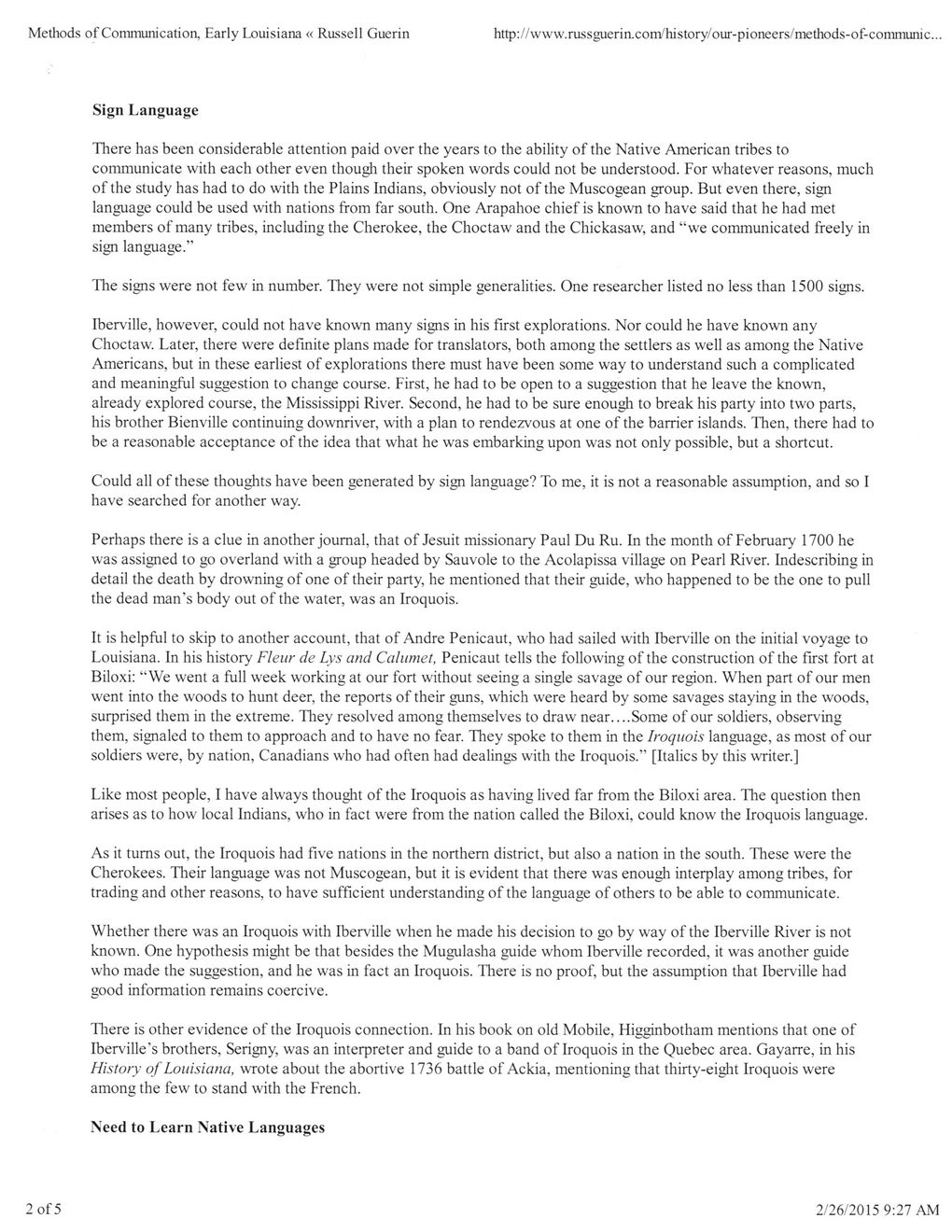This text was obtained via automated optical character recognition.
It has not been edited and may therefore contain several errors.
Methods of Communication, Early Louisiana « Russell Guerin http://www.russguerin.com/history/our-pioneers/methods-of-cornmunic. Sign Language There has been considerable attention paid over the years to the ability of the Native American tribes to communicate with each other even though their spoken words could not be understood. For whatever reasons, much of the study has had to do with the Plains Indians, obviously not of the Muscogean group. But even there, sign language could be used with nations from far south. One Arapahoe chief is known to have said that he had met members of many tribes, including the Cherokee, the Choctaw and the Chickasaw, and “we communicated freely in sign language.” The signs were not few in number. They were not simple generalities. One researcher listed no less than 1500 signs. Iberville, however, could not have known many signs in his first explorations. Nor could he have known any Choctaw. Later, there were definite plans made for translators, both among the settlers as well as among the Native Americans, but in these earliest of explorations there must have been some way to understand such a complicated and meaningful suggestion to change course. First, he had to be open to a suggestion that he leave the known, already explored course, the Mississippi River. Second, he had to be sure enough to break his party into two parts, his brother Bienville continuing downriver, with a plan to rendezvous at one of the barrier islands. Then, there had to be a reasonable acceptance of the idea that what he was embarking upon was not only possible, but a shortcut. Could all of these thoughts have been generated by sign language? To me, it is not a reasonable assumption, and so I have searched for another way. Perhaps there is a clue in another journal, that of Jesuit missionary Paul Du Ru. In the month of February 1700 he was assigned to go overland with a group headed by Sauvole to the Acolapissa village on Pearl River. Indescribing in detail the death by drowning of one of their party, he mentioned that their guide, who happened to be the one to pull the dead man’s body out of the water, was an Iroquois. It is helpful to skip to another account, that of Andre Penicaut, who had sailed with Iberville on the initial voyage to Louisiana. In his history Fleur de Lys and Calumet, Penicaut tells the following of the construction of the first fort at Biloxi: “We went a full week working at our fort without seeing a single savage of our region. When part of our men went into the woods to hunt deer, the reports of their guns, which were heard by some savages staying in the woods, surprised them in the extreme. They resolved among themselves to draw near.. ..Some of our soldiers, observing them, signaled to them to approach and to have no fear. They spoke to them in the Iroquois language, as most of our soldiers were, by nation, Canadians who had often had dealings with the Iroquois.” [Italics by this writer.] Like most people, I have always thought of the Iroquois as having lived far from the Biloxi area. The question then arises as to how local Indians, who in fact were from the nation called the Biloxi, could know the Iroquois language. As it turns out, the Iroquois had five nations in the northern district, but also a nation in the south. These were the Cherokees. Their language was not Muscogean, but it is evident that there was enough interplay among tribes, for trading and other reasons, to have sufficient understanding of the language of others to be able to communicate. Whether there was an Iroquois with Iberville when he made his decision to go by way of the Iberville River is not known. One hypothesis might be that besides the Mugulasha guide whom Iberville recorded, it was another guide who made the suggestion, and he was in fact an Iroquois. There is no proof, but the assumption that Iberville had good information remains coercive. There is other evidence of the Iroquois connection. In his book on old Mobile, Higginbotham mentions that one of Iberville’s brothers, Serigny, was an interpreter and guide to a band of Iroquois in the Quebec area. Gayarre, in his History of Louisiana, wrote about the abortive 1736 battle of Ackia, mentioning that thirty-eight Iroquois were among the few to stand with the French. Need to Learn Native Languages 2 of 5 2/26/2015 9:27 AM

Explorers Methods-of-Communication-With-Native-Americans---Guerin-(02)